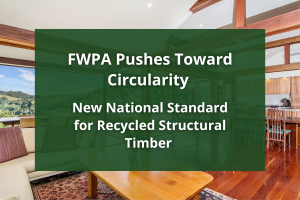A new substrate has been developed that enables hardwoods to respond better when glues are applied.
The new technology implies the potential use of bonded and coated hardwoods for a much broader range of applications in construction.
The new technology implies the potential use of bonded and coated hardwoods for a much broader range of applications in construction.
The FWPA supported research demonstrates how newly developed surface modification technology can significantly improve the strength and long-term durability of systems containing bonded and coated Australian hardwood products.
The investigations of the team from CSIRO, the University of Melbourne and Swinburne University, focused on the manufacture of hardwood bonding using adhesives made from the organic plastic ‘polyurethane’ (PU). An improvement in bond strength of up to 300 per cent was observed by applying a thin layer of a polyurethane adhesion-promoter formulation — known as CSIRO Surf-BOND — to the surface of the wood prior to the bonding process.
Team Leader at CSIRO, Dr Xiaoqing Zhang said this new technology has the potential to inspire a significant increase of hardwood usage in the Australian building and construction sector.
“The approach provides a strong and durable bond with exterior coatings, helping maintain adhesion and the natural appearance of hardwood, meaning better retention of decorative, visual attributes,” said Dr Zhang.
What’s more, the benefits became even more pronounced when bond performance was assessed after exposure to environmental conditions including high temperatures and extreme wetness and dryness. These results were validated in scenarios ranging from laboratory-scale testing, right through to pilot-scale trials, and a final demonstration during industrial trials conducted at the Australian Sustainable Hardwoods (ASH) Heyfield manufacturing plant.
In addition, several clear coatings were identified by the researchers as providing boosted protection for surface-finished exterior hardwood products. As validated through long-term accelerated weathering assessments, selected high-gloss and low-gloss clear coats survived up to 2,000 hours of Q-Sun or 4,000 hours of QUV testing, when used on various hardwood species.
After this accelerated weathering, the coating layer retained high strength of adhesion to the hardwood surface, while the wood products also maintained their natural appearance.
“These results provide a promising solution for coated hardwoods in outdoor applications by overcoming surface damage upon solar exposure and alleviating the high-cost maintenance currently associated with exterior wood products.
“The outcomes of this research also create the potential for further innovation of architectural systems to be manufactured, surface finished and assembled off-site, ready for installation at the designated construction site,” Dr Zhang said.
ASH is now in the process of bringing Surf-BOND to market, with further industry demand expected going forward.
The research findings can be found in full by clicking here.



